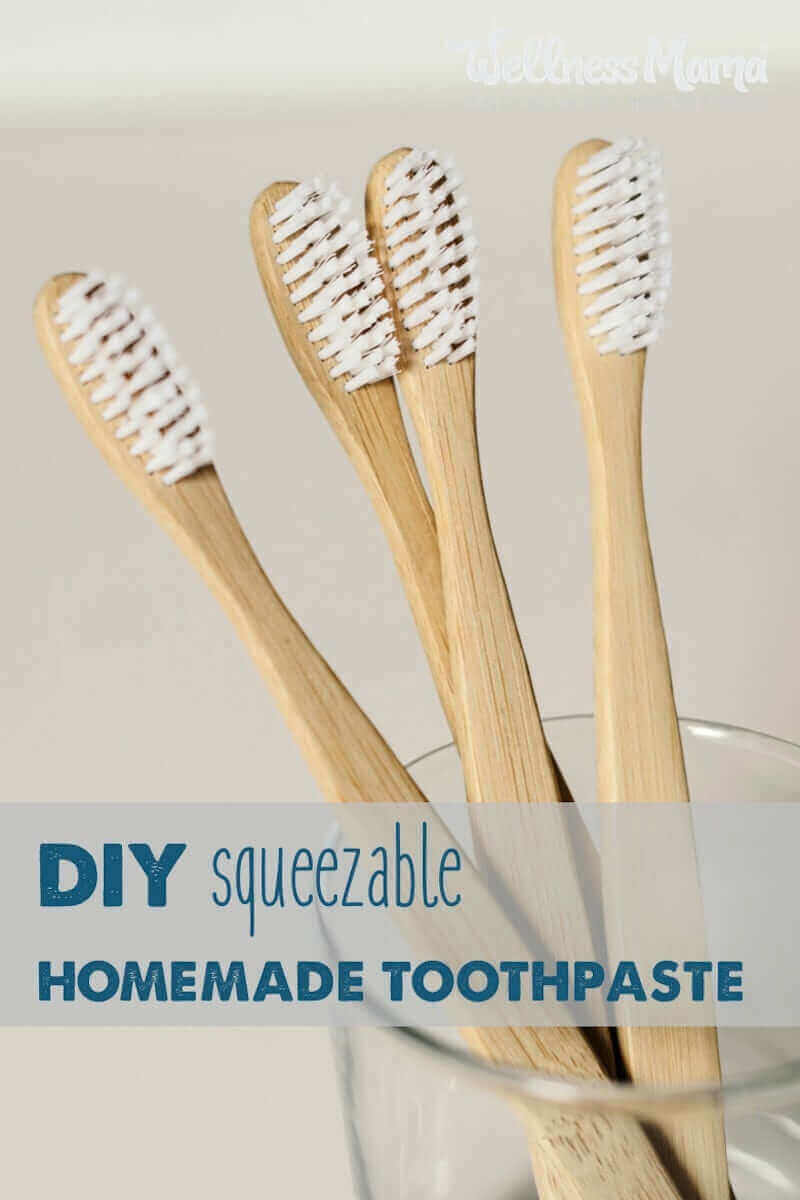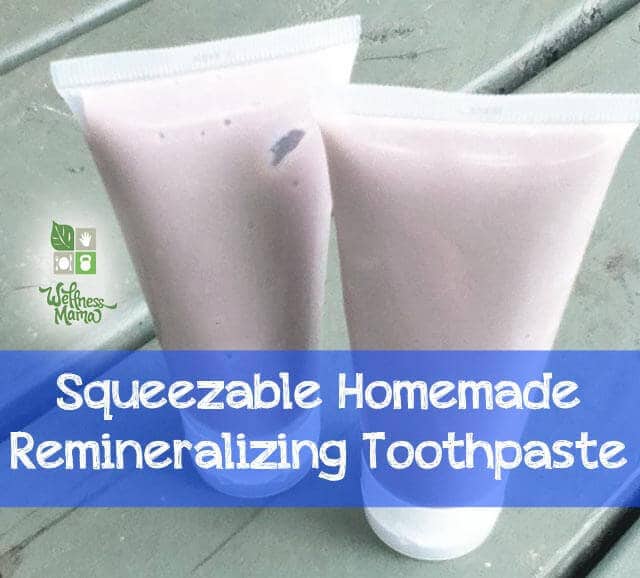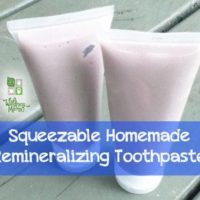I’ve posted my recipe for remineralizing homemade toothpaste before, and a reader recently shared her adaption that allows it to be squeezable (many thanks to Melina!) It also combines the bentonite clay of the toothpowder recipe with the remineralizing recipe for a double dose of minerals.
The addition of water to this recipe makes it squeezable, but also shortens the shelf life. I haven’t been able to test it past a few weeks because we use it so quickly, but it has lasted at least that long at our house. A reader suggested adding vodka in place of the water.
The squeezable tube also offers the advantage of making a toothpaste that is easier to share without having to dip multiple toothbrushes into the same container.
If you’d rather use a water-free homemade toothpaste recipe with an indefinite shelf life or a toothpowder recipe, my entire list of oral health recipes is on my Oral Health Resource Page.
Squeezable Homemade Toothpaste Recipe
Equipment
Materials
- 5 TBSP calcium carbonate powder
- 3 TBSP xylitol powder (optional)
- 4 TBSP coconut oil (room temperature)
- 1 TBSP baking soda (optional)
- 2 TBSP bentonite clay (or additional calcium carbonate)
- 3 TBSP distilled water
- 30 drops essential oils (such as peppermint, cinnamon, etc.)
- 20-30 drops trace minerals (optional)
Instructions
- Mix all the ingredients except clay in a mini-food processor and mix well to incorporate.
- Once smooth, slowly add in the bentonite clay and mix by hand with a plastic utensil (bentonite clay should not come in contact with metal). If you don’t have a food processor, you can use an immersion blender or even a whisk/fork in a bowl. Do not use an air-tight blender like a magic bullet as this create too much pressure
- Store in a small jar or a squeezable tube like this BPA free GoTube.
- Use as you would regular toothpaste.
Notes
- Due to the nature of the coconut oil, this homemade toothpaste will be thicker when cooler and thinner when heated, but should be a squeezable consistency at normal room temp (70-75 degrees). If it is too runny or too thick, try adding more water or calcium to get desired thickness.
- Adjust essential oils to taste.
Homemade Toothpaste FAQs
Q. What is the best type of calcium/calcium magnesium to use?
After trying a lot of different types of calcium and calcium magnesium powders and getting reader feedback from dozens of readers… the consensus is that Calcium Carbonate is the best option and that certain types of calcium magnesium can cause reactions. (I use this brand)
Q. I had an explosive reaction while making this… what happened?
Likely, you used calcium magnesium in a closed container, which apparently can cause a pressure reaction in certain situations. I recommend mixing by hand or in a container that is not airtight. Magic bullets seem to be the culprit in most cases.
Q. Is this okay for sensitive teeth/fillings/veneers/children/etc?
Always check with a dentist before changing a dental routine especially if you have any dental conditions. I personally use this on my kids and on my own teeth with a couple of non-amalgam fillings (before I knew about remineralization). Again, check with a dentist, but since all ingredients are generally considered safe for consumption, I feel comfortable using it.
Q. What are some common reactions in the first few weeks (heightened sensitivity for some)?
I personally didn’t have any reactions, but it seems that some people do experience sensitivity for the first couple of weeks of using homemade toothpaste, especially if they’ve been using commercial products for a long time or have had recent fluoride treatments as the clay can bind and pull out toxins. This seems to be less of an issue with calcium powder and seems to resolve itself within a few weeks, but again check with a dentist.
Q. Xylitol vs. stevia, which is better?
This is largely a matter of opinion. Some studies show that xylitol is good for the teeth, while others show it can be dangerous. It is dangerous to animals, so be very careful to keep it out of the reach of any pets! We use this brand which is not derived from corn and which is not GMO.
Q. Vodka vs. Water?
This recipe works just fine with water, but many people have successfully used vodka in its place to extend the shelf life (it lasts pretty long either way.)
Q. Why NO Glycerin?
There is some evidence that glycerin can coat teeth and prevent them from absorbing minerals. The research definitely seems mixed on this one, but there is no evidence that glycerin is needed or beneficial to the teeth, so it is best avoided. On a personal level, I’ve seen relatives’ teeth turn brown after using glycerin-based toothpaste and return to normal once switching to different brands.
Q. Other than yourself and your family, has anyone else used this for a while?
I have received dozens of emails from people who have used this toothpaste or my regular remineralizing toothpaste and had good results. One reader, Jennifer, backed the idea of using calcium and not calcium magnesium:
I’ve always made it with calcium powder and love it. We bought the calcium magnesium powder this time and it tastes and feels like tingly, bitter metal – and not tingly in a good way. We will stick with the regular calcium carbonate powder.
Tina offered these changes:
I started adding a bit of hydrogen peroxide to mine. That made it squeezable. I do not use the bentonite clay. Instead I use baking soda. I also add a few drops of grapefruit seed extract to mine. There is still the fact that coconut oil is more firm in cooler temps. Thanks for sharing the container information! I have tried using pastry tips with disposable plastic bags.
Melinda adds:
I love this toothpaste recipe and have been using the original but my paste always dries up. I’ll have to play with it more. This recipe really does make my teeth look and feel fantastic. I love it! May have to get a squeezable tube and see how that goes.
Q. I had bleeding gums the first few times I used this, is this normal?
I didn’t experience this personally, but have heard from many readers that they had this for the first few days and up to two weeks but from their experience, it seemed to resolve itself. If in doubt, ask a dentist!
Q. What type of container is best for this?
I personally use goToobs which are medical grade silicon and great for re-using, traveling and squeezing without worry of plastic leaching in to the toothpaste or metal deactivating the bentonite clay. I’ve had one of these and it has lasted a year and is still going strong. I also use them for my oil cleansing blend when traveling since they don’t leak.
Ever made your own toothpaste or oral health products? How did it go? Share below!




Leave a Reply